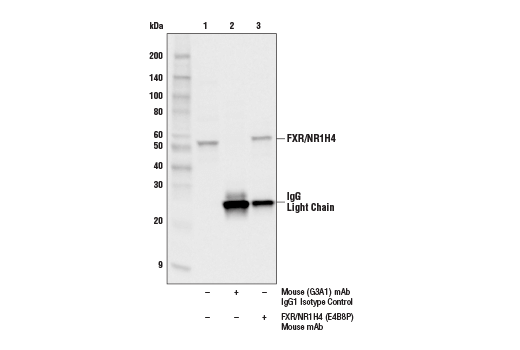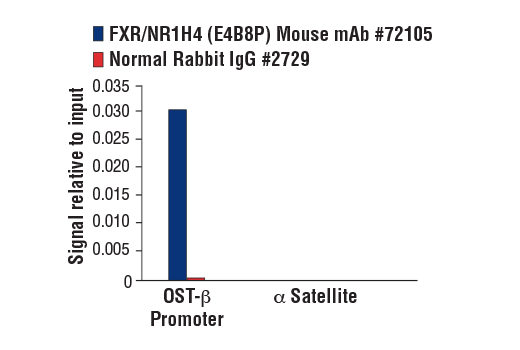WB, IP, ChIP
H M
Endogenous
55
Mouse IgG2a
#Q96RI1
9971
Product Information
Product Usage Information
For optimal ChIP results, use 10 μl of antibody and 10 μg of chromatin (approximately 4 × 106 cells) per IP. This antibody has been validated using SimpleChIP® Enzymatic Chromatin IP Kits.
| Application | Dilution |
|---|---|
| Western Blotting | 1:1000 |
| Immunoprecipitation | 1:200 |
| Chromatin IP | 1:50 |
Storage
Specificity / Sensitivity
Species Reactivity:
Human, Mouse
Source / Purification
Monoclonal antibody is produced by immunizing animals with recombinant protein specific to the amino terminus of human FXR/NR1H4 protein.
Background
The farnesoid X receptor (FXR/NR1H4) is a member of the nuclear hormone receptor superfamily and is a master regulator of bile acid synthesis. FXR/NR1H4 heterodimerizes with RXR-alpha upon activation by bile acids, which begins a regulatory cascade involving SHP and LRH-1 to control lipid homeostasis (1-5). FXR/NR1H4 has also been shown to be a critical regulator of glucose homeostasis (6,7). In addition to directly regulating genes, FXR/NR1H4 also plays a post transcriptional role in bile acid metabolism by transcribing the RNA-binding protein ZFP36L1, which in turn downregulates the key enzyme Cyp7a1 (8). Mutations in human FXR/NR1H4 have been shown to cause cholestasis and liver disease in neonatal patients (9). FXR/NR1H4 can also control Lgr5+ intestinal stem cell proliferation and its upregulation has been shown to inhibit colorectal cancer progression (10-12). Agonists against FXR/NR1H4 are being evaluated for various liver diseases and diabetes (13-16).
- Parks, D.J. et al. (1999) Science 284, 1365-8.
- Wang, H. et al. (1999) Mol Cell 3, 543-53.
- Laffitte, B.A. et al. (2000) J Biol Chem 275, 10638-47.
- Edwards, P.A. et al. (2002) J Lipid Res 43, 2-12.
- Goodwin, B. et al. (2000) Mol Cell 6, 517-26.
- Ma, K. et al. (2006) J Clin Invest 116, 1102-9.
- Zhang, Y. et al. (2006) Proc Natl Acad Sci U S A 103, 1006-11.
- Tarling, E.J. et al. (2017) J Clin Invest 127, 3741-54.
- Gomez-Ospina, N. et al. (2016) Nat Commun 7, 10713.
- Modica, S. et al. (2008) Cancer Res 68, 9589-94.
- Fu, T. et al. (2019) Cell 176, 1098-1112.e18.
- Qiao, P. et al. (2018) Oncol Rep 40, 2067-78.
- Pellicciari, R. et al. (2002) J Med Chem 45, 3569-72.
- Hirschfield, G.M. et al. (2015) Gastroenterology 148, 751-61.e8.
- Neuschwander-Tetri, B.A. et al. (2015) Lancet 385, 956-65.
- Genin, M.J. et al. (2015) J Med Chem 58, 9768-72.
Species Reactivity
Species reactivity is determined by testing in at least one approved application (e.g., western blot).
Western Blot Buffer
IMPORTANT: For western blots, incubate membrane with diluted primary antibody in 5% w/v BSA, 1X TBS, 0.1% Tween® 20 at 4°C with gentle shaking, overnight.
Applications Key
WB: Western Blotting IP: Immunoprecipitation ChIP: Chromatin IP
Cross-Reactivity Key
H: human M: mouse R: rat Hm: hamster Mk: monkey Vir: virus Mi: mink C: chicken Dm: D. melanogaster X: Xenopus Z: zebrafish B: bovine Dg: dog Pg: pig Sc: S. cerevisiae Ce: C. elegans Hr: horse GP: Guinea Pig Rab: rabbit All: all species expected
Trademarks and Patents
Limited Uses
Except as otherwise expressly agreed in a writing signed by a legally authorized representative of CST, the following terms apply to Products provided by CST, its affiliates or its distributors. Any Customer's terms and conditions that are in addition to, or different from, those contained herein, unless separately accepted in writing by a legally authorized representative of CST, are rejected and are of no force or effect.
Products are labeled with For Research Use Only or a similar labeling statement and have not been approved, cleared, or licensed by the FDA or other regulatory foreign or domestic entity, for any purpose. Customer shall not use any Product for any diagnostic or therapeutic purpose, or otherwise in any manner that conflicts with its labeling statement. Products sold or licensed by CST are provided for Customer as the end-user and solely for research and development uses. Any use of Product for diagnostic, prophylactic or therapeutic purposes, or any purchase of Product for resale (alone or as a component) or other commercial purpose, requires a separate license from CST. Customer shall (a) not sell, license, loan, donate or otherwise transfer or make available any Product to any third party, whether alone or in combination with other materials, or use the Products to manufacture any commercial products, (b) not copy, modify, reverse engineer, decompile, disassemble or otherwise attempt to discover the underlying structure or technology of the Products, or use the Products for the purpose of developing any products or services that would compete with CST products or services, (c) not alter or remove from the Products any trademarks, trade names, logos, patent or copyright notices or markings, (d) use the Products solely in accordance with CST Product Terms of Sale and any applicable documentation, and (e) comply with any license, terms of service or similar agreement with respect to any third party products or services used by Customer in connection with the Products.


